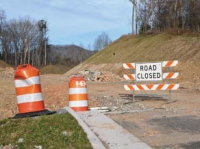Ushering in a new era in Maggie Valley
A whole lot of residents and business owners are excited — and that’s putting it mildly — about Ghost Town’s May 25 re-opening. It’s probably the most anticipated business event in years in Haywood County, and there’s good reason to believe that the additional tourist traffic will have a positive economic impact on the entire region.
The most interesting aspect of the theme park’s rebirth, however, may be how its closing four years ago helped transform Maggie Valley. Over the coming years, in fact, it will be interesting to note how the new Maggie Valley and the new Ghost Town co-exist. That’s not to suggest it won’t be a good relationship, because there’s every indication it will be. But it will be fundamentally different than Ghost Town’s first incarnation.
When R.B. Coburn opened Ghost Town in 1961, it put Maggie Valley on the map. Over the next two decades the town became, arguably, Western North Carolina’s best-known destination. People around the country who had never heard of Waynesville, Boone, Brevard, Franklin or even Asheville would give a familiar nod when asked about Maggie Valley. Millions of people, literally, came to visit the old west theme park.
For the most part, Maggie Valley was a one-horse town. Sure, other amenities sprang up, and long-time resorts like Cataloochee Ranch and even the ski area did well, but it was Ghost Town that drove the traffic. To this day, people walk in local visitor centers and ask how to get to the theme park, never imagining that it had closed.
When it did shut down in 2003, Maggie Valley almost did the same. Brenda O’Keefe, the well-known owner of Joey’s Pancake House, estimates business in the valley dropped by as much as 60 percent.
But life went on even though people continued to fret about Ghost Town closing. Maggie Valley not only survived, it started coming back. Cataloochee Ski Area invested heavily in snowmaking and other amenities, in the process becoming one the South’s premier ski resorts and making it profitable for many businesses to stay open all winter. Wheels Through Time owner Dale Walksler’s dogged marketing of his museum has helped to bring a new set of well-heeled motorcycle enthusiasts to the valley. Eaglenest Entertainment, Carolina Nights and a number of other businesses also found ways to stay alive and provide a reason for people to come to Maggie Valley and something for them to do once they got there. Having Harrah’s just over Soco Gap has also helped.
Related Items
Aside from the hardscrabble work of individual businesses, the valley as a whole took advantage of Western North Carolina’s soaring popularity as a second-home destination. New developments like Smoky Mountain Retreat have sprang up in many of its coves, providing customers for restaurants and other businesses. The new Maggie Valley Club is probably the best example of the community’s relatively newly established label of resort destination.
There have been other changes in recent years. The town has put in sidewalks and a master greenway plan has been developed in an effort to make the one-road town more walkable. Maggie Valley Festival Grounds is a great addition. Outdoors enthusiasts who want to visit the Great Smoky Mountains National Park or the Blue Ridge Parkway also continue to use Maggie Valley as a staging area because of its many small, relatively inexpensive motels and its strategic location.
The point is that Ghost Town will now be a part of a multi-faceted tourist town and resort community. Although it should become the biggest player in town, it won’t be the only one. All roads won’t lead to Ghost Town, and in the long run that bodes well for the economic health of Maggie Valley.









